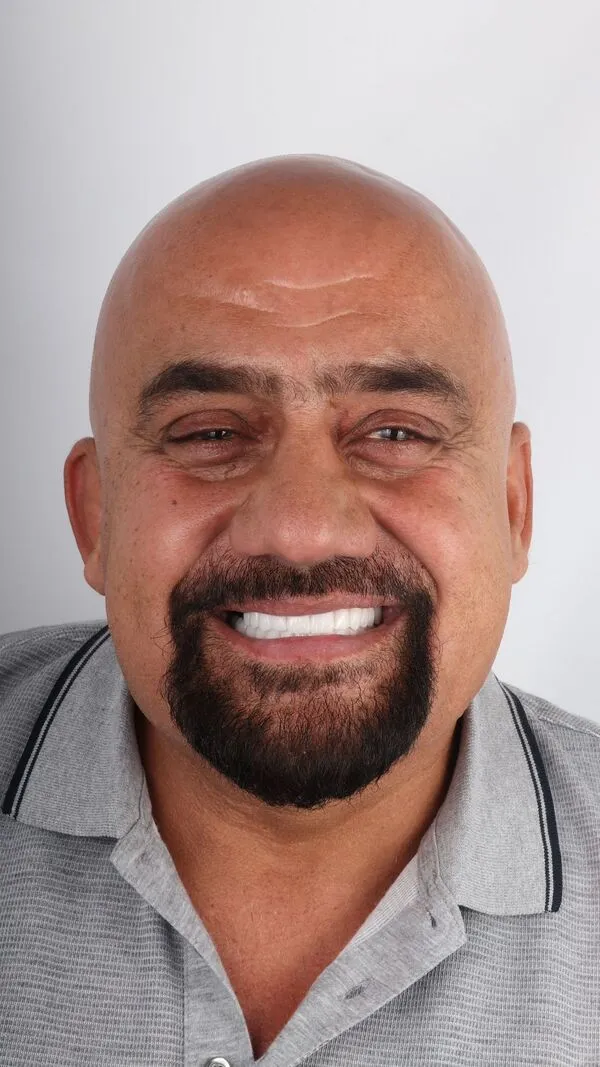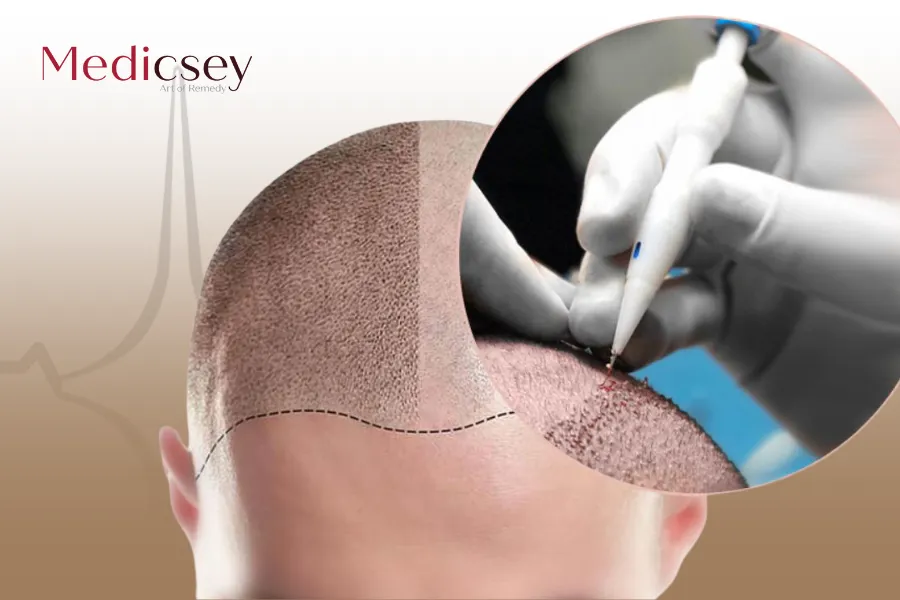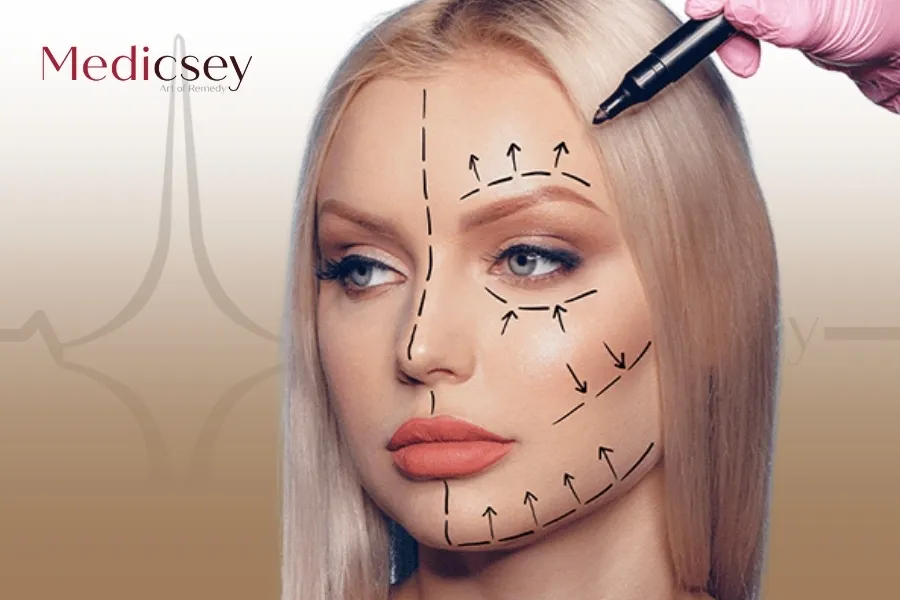Table of Contents
- How does DHI hair transplantation work in Syria?
- Who needs a DHI hair transplant in Syria?
- DHI Vs. FUE & FUT techniques
- DHI Vs. Sapphire FUE techniques
- Side effects and precautions for DHI hair transplant in Syria
- DHI hair transplant cost
- Frequently Asked Questions
- What is DHI hair transplantation technique?
- Is DHI painful?
- When do the results of DHI hair transplantation appear?
More than 85% of men experience hair loss by the age of 50, and more than 50% of women experience noticeable hair loss throughout their lives. Should we keep these rates this high?
Certainly not. As is well known, science has advanced and brought us many essential solutions to hair loss problems, and one of the most prominent solutions is hair transplantation using the DHI technique in Syria.
Direct Hair Implantation (DHI) is an advanced and revolutionary hair transplantation technique developed by DHI Global Medical Group that uses a specialized pen-shaped tool to directly implant extracted hair follicles.
Let's explain everything you need to know about the Direct Hair Implantation (DHI) procedure we perform at Medicsey Clinic, Best Direct hair implantation clinic, and we'll also compare it with FUT, FUE, and Sapphire techniques to help you decide which is best for you.
How does DHI hair transplantation work in Syria?
In DHI hair transplant in Syria, after the surgeon removes hair follicles from a part of your scalp using the FUE technique, usually the back of your head, he implants them in the bald areas using the direct implantation technique. These follicles will eventually grow to produce new hair.
Here's what you can typically expect during the procedure:
The surgeon will shave your head and apply a local anesthetic to numb it.
The surgeon will extract hair follicles from the back of your head using a fine-tipped instrument called a micromotor using the FUE technique.
The hair follicles will be loaded into a pen-shaped device called a Choi pen and implanted into the bald part of your scalp.
The surgeon will apply an antibiotic cream and bandage all areas.
FUE and DHI surgeries typically take about 8 hours, but the exact time may vary depending on the number of hair follicles transplanted. It takes 6 to 12 months to see the full results of the surgery.
Who needs a DHI hair transplant in Syria?
People with androgenetic alopecia, the most common type of hair loss, are the best candidates for hair transplantation. This condition is commonly known as male or female pattern hair loss.
The following characteristics also make you a good candidate for hair transplantation:
- Age: People undergoing hair transplantation must be over 25 years old, as hair loss before this age is less predictable.
- Hair diameter: People with thick hair typically achieve better results than those with thin hair. Thicker hair provides more coverage per hair follicle.
- Donor hair density: Patients with hair density less than 40 follicles per square centimeter in the donor area are considered unsuitable candidates for hair transplantation.
- Hair color: People with light hair or hair that is close to their skin tone often achieve better results.
DHI Vs. FUE & FUT techniques
FUE and FUT techniques involve taking hair follicles from one part of the scalp and implanting them in bald areas, whereas DHI is used to implant hair in the bald area.
During a FUT surgery, the doctor takes a narrow strip of skin from the back of the head. Hair follicles are taken one by one and placed along the hairline. This is generally the quickest and most affordable way, but it may still result in a scar going all the way. If you have short hair, the scar will be very visible, but long hair can usually cover it well. However, this method is really old-fashioned and is not being used now.
An FUE surgery consists of the fact that hair follicles are taken from the scalp directly without any intermediate, the surgeon uses a machine that pulls the follicles out.
DHI and FUE techniques avoid the long scar caused by FUT, however, these surgeries take longer and are more expensive.
Medicsey Clinic in Syria combines the FUE and DHI techniques, using the FUE technique to extract hair follicles and the DHI technique to implant them directly. This method guarantees the success of the procedure and 100% hair growth.
DHI Vs. Sapphire FUE techniques
|
Item |
DHI (Direct Hair Implantation) technique |
Sapphire FUE technique |
|
The tool used |
Choi Implanter Pen |
Sapphire Ambassador Blades |
|
Planting method |
Direct implantation without opening channels |
Open channels first using sapphire blades and then implant |
|
Achievable hair density |
High and accurate in directing the follicles |
High, especially for large areas |
|
Control the direction of planting |
Very accurate |
very good |
|
swelling and bleeding |
relatively less |
average |
|
Duration of the operation |
Longer (approximately 8-10 hours) |
Shorter (6-8 hours) |
|
Suitable for what type of hair? |
Suitable for fine hair and front areas |
Suitable for large spaces and backyards |
|
Recovery and return to daily life |
relatively faster |
Also fast but with a little more bloating. |
|
Final results |
Very natural and accurate |
Natural and dense |
Side effects and precautions for DHI hair transplant in Syria
Hair transplant surgeries are relatively safe and rarely cause complications. DHI and FUE techniques are less invasive than FUT because they do not require the surgeon to cut a large strip of skin.
Many studies claim that FUE techniques do not leave scars, but they do cause a series of small scars resulting from the removal of individual hair follicles. These scars are usually unnoticeable. Here are some potential complications of DHI hair transplant in Syria:
- Adverse reaction to anesthesia
When DHI is being performed, a local anesthetic is used on the scalp to make it numb. Anesthesia is typically safe, but it can lead to negative reactions in some individuals. However, most of the cases of reactions are not caused by local sensitivity to anesthetics, but are rather related to fear or anxiety.
- infection
The infection can occur in the donor area of or in the place where the hair follicles have been implanted. Severe infections are quite rare, that is why they occur in less than 1% of hair transplantation surgeries.
- sudden hair loss
Sudden hair loss can occur within two months of surgery. This is a temporary loss of hair at the hair transplant site and is considered a normal condition. Complete recovery usually takes 3 to 4 months.
- undesirable appearance
When hair follicles are transplanted, they must be arranged in a way that mimics your natural hair growth. If the follicles are transplanted incorrectly, this may result in an unsatisfactory appearance.
Fortunately for you, dear reader, you are here because the surgeons at Medicsey Clinic, Best Direct hair implantation clinic, are equipped with extensive experience to ensure the perfect appearance of your hair.
Other complications
Other potential complications of hair transplant surgeries include:
- bleeding
- vertigo
- pain
- increased heart rate
- folliculitis
- The appearance of light hair around the donor area
- mourning
DHI hair transplant cost
The cost of hair transplantation varies greatly depending on the city where the procedure is performed, the clinic you visit, and the total amount of hair transplants.
To reduce costs, you may want to consider traveling to a less expensive geographic area with high-quality hair transplants, such as Syria.
|
The cost of DHI hair transplant in Syria |
1200 US dollars |
You may request a medication to support hair follicle growth after transplantation, and Medicsey's options include the following:
- Minoxidil (Rogaine)
- Finasteride (Propecia)
- Low-level laser therapy
Frequently Asked Questions
What is DHI hair transplantation technique?
It is a technique that uses a Choi pen to implant follicles directly without the need to open channels in advance, which provides greater precision and control over the direction of implantation.
Is DHI painful?
It is painless as it is performed under local anesthesia, and the patient usually feels only mild discomfort after the procedure.
When do the results of DHI hair transplantation appear?
Results start to appear after 2 months, and the final result is within 6 to 12 months.
Bottom line
DHI hair transplant in Syria is the latest technique used to transplant follicles after extracting them using the FUE technique. This method can treat hair loss caused by pattern baldness in both men and women. Contact us via WhatsApp and book your free consultation and plan to restore your perfect appearance!
Read more: Rhinoplasty in Syria









.webp)


.webp)


.webp)